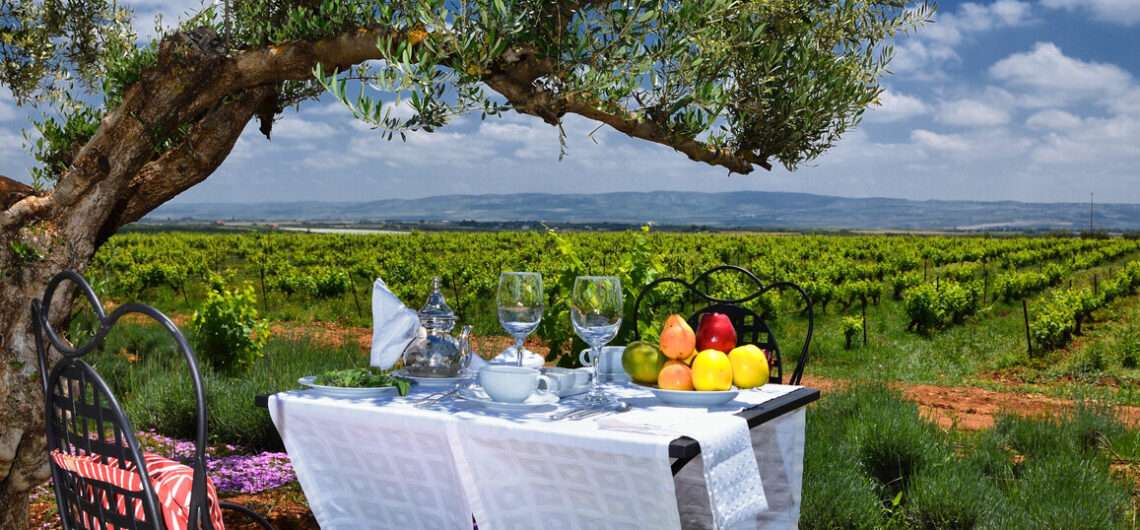The viticulture in Morocco and the planting of the first vineyards date back to the Phoenicians and the Roman colonisation. In ancient times, the major centre of wine production was concentrated around Volubilis, in the region of the present-day city of Meknes.
Morocco remains one of the last lands wild vines on earth. As early as antiquity, Pausanias the Periegete noted that the inhabitants of Lixus, a city founded by the Phoenicians on the right bank of the Loukkos wadi, consumed the fruit. Louis Levadoux indicates that ‘The Berbers do not neglect this supplement: when autumn comes, the people of Guergour go high up into the forests of the Atlas to pick the grapes from the trees, which they eat fresh or dry on racks’.
Click here, to book a place with us for a winery tasting tour.
The ampelographer was able to find, in the valley of the Oued Titria, these lambrusques known as Aneb djalia. He notes that “Some of them bear a strong resemblance to the grape varieties cultivated by the Berbers”.
The first wines were produced around the second century BC during the installation of Phoenician and Greek trading posts.
It was the Roman colonisation that developed viticulture in Morocco, allowing the wines of Mauritania to be presented on the patrician tables. This province corresponded to the northern part of present-day Morocco. It extended from the north, to Salé , to Volubilis in the south, and to the east in the Oued Laou river. The main cities were Volubilis, Tingis (Tangier), Lixus (Larache) and Tamuda (Tetouan).
The Muslim conquest did not make the North African viticulture disappear. It privileged the table grape. The Moroccan, Islamized, Berbers, when they arrived in the Iberian Peninsula, brought their varieties. One of these is still cultivated in Andalusia, it is the white Faranat of Tunis, known in Spain as Majorcan. In Al Andalus, many Muslim agronomists described viticulture, the different Andalusian grape varieties and their cultivation methods. The vineyards continued to produce wine, to which was added palm wine, made from dried grapes and considered not prohibited. All the emirs and caliphs of Moorish origin were great drinkers and the palaces of Granada, Cordoba, Seville, Medinaceli and Almeria were famous for their wines and the drinking that took place there.
In Morocco, the various Muslim rulers tolerated the Jewish communities that resided in their neighborhoods, the mellah. It was there that Jews could drink wine but were forbidden to sell it. Many had their own vineyards. Al Hasan Ibn Muhammad Al Zayyati Al Fasi Al Wazzan, known as Leon the African, noted in 1525 that in Taza, this was the case for five hundred families. The communities settled in Demnate, Mogador and Marrakech had the same rights of ownership and vinification.
The same licenses were granted to resident Christians. Firstly, to the Sultan’s mercenaries, a militia that had been created as early as the seventh century, and secondly to the consular corps. At the beginning of the fourteenth century, the members of the Genoa Consulate had Fondouks in Ceuta, Arzila, Larache, Salé and Anfa. The taverns there sold wine from the countries of the northern Mediterranean. In the statutes of Marseille, 1228, it is mentioned that the Manduel sell wine from Provence in Ceuta. Leon the African, in the 16th century, estimated the number of these drinking establishments in Fez at two hundred. He also noted that “some men had wine for sale in their homes, and each man could use it in peace without the court taking offense.
In Portuguese Morocco (August 15, 1415 – March 11, 1769), the Portuguese planted vines when they settled in Azemmour, Safi and El Jadida, a foreshadowing of today’s Doukkala vineyards.
For the Moroccan Jewish community, wine production continued until the 20th century. Vines were grown in the gardens. However, it was reported that at the end of the protectorate the quality of this kosher was unsatisfactory: “Kosher red wine is abominable, especially the Dahlia wine made by the cousin Salomon Amar. There is no valid kosher wine production.”
With the colonization of the 20th century, the French developed viticulture in Morocco as well as in Algeria and Tunisia. As phylloxera had ravaged most of the European vineyards by 1875, vineyards were created in North Africa by French merchants to supply themselves with wine. They were quickly joined by their Spanish and Italian colleagues.
In Morocco, the choice of land was preponderant and the vines planted in the sandy soils of the Chaouïa, Trifas and Sahels regions were resistant to disease, as the insect could not live in the sand. Some French grape varieties were grafted, the culture became intensive and, from 1880, whole boats arrived in Europe loaded with grapes. It was from 1905 that the first pinardiers left Casablanca and unloaded in European ports.
Four grape varieties had been selected as being the most suitable for the terroirs to produce the desired wines. These were Grenache, Carignan, Cinsault and Alicante Bouschet. This was the beginning of the mass production of Moroccan viticulture and the era of high grade medical wines used in blending. Before the First World War, 80,000 hectares were cultivated with vines, which offered them a large outlet. Production was then based on volume rather than quality, with many Moroccan wines being sent to Languedoc to enrich the alcohol content of the mass production of table wines in this wine region. Hence the choice of grape varieties from the Midi and Spain, large producers, introduced by the colonists
In 1923, a Belgian company set up a winery near Ben Slimane, in the Casablanca region. The first harvest took place in 1927. This was the beginning of modern Moroccan viticulture. Thalvin-Ebertec is the owner of this estate and bears the name of Ouled Thaleb.
In this period of prosperity, the vineyard area exceeded 55,000 hectares with a production of 3,500,000 hectoliters. Domains of several hundred hectares around Meknes, Rabat, Tiflet and Khemisset. The cellar of Aït Souala, in Meknes, remains the witness and symbol of this euphoric period.
By the end of the 1950s, the area planted with vines exceeded 65,000 hectares and more controlled yields had reduced production to 3,000,000 hectoliters.
In 1956, with independence, the Moroccan kingdom inherited these wineries and vineyards, but viticulture reduced its hold for both cultural and religious reasons.
In addition, in 1967, the Treaty of Rome prohibited the blending of European community wines with those from abroad, and Morocco lost this market and faced a crisis of overproduction.The vines were uprooted and the cellars closed, the viticulture fell into decay.
However, this measure gave a new impetus to Moroccan production, they’ve forced wine growers to abandon the bulk to turn to the bottle. This was the appearance of modern production units where they made more qualitative grape varieties as chardonnay, roussanne, syrah, cabernet…
In the early 2000s, 12,000 hectares were cultivated for a production of between 350,000 and 450,000 hectoliters.
The region of Meknes alone representing nearly half of the Moroccan vineyard. This period is marked by the arrival of the French Castel and the creation of the Domaine de la Zouina. The official laboratory for chemical analysis and research for wine is located in Casablanca. Since then, Morocco is a member of the International Organization of Vine and Wine. In 2008, it produced 35 million bottles.
Since 2011, the new government , has created another political climate that is less favorable to wine consumption by Moroccans themselves. The increase in taxes on alcoholic beverages had a bad effect, since 85% of the production locally.
Despite this restrictive policy, wine remains a booming economic sector, with a production of over 40 million bottles per year. This makes Morocco the second largest wine producer in the Arab world. In addition, the wine sector generates 20,000 jobs and brought, in 2011, 130 million euros.



Comments